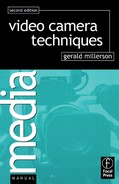The camera may need to move at speeds from an almost imperceptible ‘creep’ to a rapid dash – smoothly, accurately and safely.
If a camera mounting is ultra-lightweight (e.g. a flimsy rolling tripod), camera judder or swaying shots during movement are not easily avoided; especially if the camera is much lower or higher than eye-level. Where possible, give the dolly a slight push in the appropriate direction while off shot. This aligns its casters, and avoids an initial jerk on moving.
Take care not to strain yourself when operating a studio pedestal that relies on heavy internal counterbalance weights. A rather cumbersome mounting, it requires some effort to get it moving and to stop. It’s all too easy to damage nearby furniture, walls – or anyone in its path. Gentle foot pressure on the base helps to start a dolly move.
Where the left panning handle (pan-bar) has a central joint, some people prefer to have its end folded upright, rather than straight out horizontally. They can then reposition a lightweight mounting by pushing/pulling the handle end, while keeping the fingers of their left hand round the ‘thumb-twist’ zoom control. Their right hand is on the focus control – which may be on the other panning handle, or at the side of the camera head. This aproach avoids the need to leave the controls to push the pedestal’s steering wheel. The result is less strain and greater control; and camera handling is easier for steep downward or upward tilts.
Unsteady pictures can give a highly dramatic sense of urgency to a news item, or suggest that someone is being jostled by a crowd. But your normal aim will be smooth, deliberate, unobtrusive camera handling.
It is best to continually check focus for maximum sharpness whenever the subject or your camera moves; rather than make obvious corrections whenever it becomes soft-focused. If both subject and camera are moving (getting closer or further away), focus-following will become correspondingly harder.
The speed of camera moves needs to be artistically appropriate too. Slow dollying can create gradually increasing interest. So it is most suitable for gentle, barely perceptible changes – in serious, thoughtful situations. But slow moves can also become tedious, boring, frustrating. Fast dollying can be dramatic and exciting – but can you stop at the end?
Camera movements
The camera head can tilt up/down, and turn to pan left/right. It can also be raised or lowered on its mounting (elevate/depress; ped up/ped down). The entire mounting can move forwards/backwards (dolly or track in/out), and move sideways (truck or crab left/right). Similarly, it can arc round a subject.

